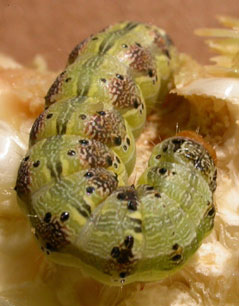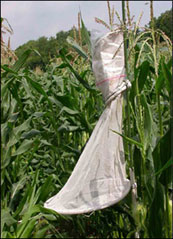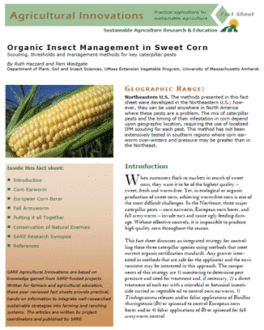
Corn Earworm (Helicoverpa zea)
The corn earworm -- also known as tomato fruitworm or cotton bollworm -- is a widespread pest. In southern areas of the U.S., corn earworm over-winters and infests sweet corn throughout the season. Corn earworm moths reach northern states through annual migrations, invading late-season corn from mid-July through September. In New England, large numbers of moths can arrive suddenly on storm fronts that move up the coastline and river valleys. The heaviest numbers are found in coastal areas, but corn earworm can be a devastating pest in late-season corn anywhere in the Northeast.
Adult moths have light tan scales and are about 1 ¼ inches in length. Distinctive features are a dark spot on the forewing, a dark band near the margin of the hind wing and, in live moths, bright green eyes. Female moths lay single cream-colored, globe-shaped eggs on the silk as well as other parts of the plant. They are attracted to the odor of corn silk; dried silks are less attractive than fresh silk as egg-laying sites. They lay an average of five eggs per day over their seven- to14-day life span. Eggs hatch in three to seven days, depending on temperature, and newly hatched larvae move directly down the silk and into the ears to feed at the tip of the ear. Unlike European corn borer and fall armyworm, earworm larvae do not tunnel through the husk to reach the ear. Corn earworm caterpillars reach 1 ½ to 2 inches when full grown and have small bumps and hairs that give the body a rough texture. They can be brown, tan, green, or pink, with light and dark longitudinal stripes (Photo A). Their head capsule is always golden brown.
Monitoring and thresholds
Trapping moths is a critical IPM tool for monitoring corn earworm flight activity. Either blacklight or pheromone traps baited with corn earworm lures can be used. Blacklight traps can be placed near corn fields, but not necessarily in them, and give a reasonable estimate of populations up to one mile away from fields. Traps should be checked daily, and capture of any corn earworm moths should trigger treatment [1]. The pheromone trap should be placed in freshly silking corn with the lure at ear height (Photo B). Lures are suspended in an opening at the base of the trap and replaced every two weeks. Two traps per field, at least 50 feet apart, are recommended. When the silk dries, move the traps to a new block of corn in fresh silk. Count the moths captured in each trap twice weekly. Trap captures totaling two moths per week per trap indicate that a damaging population of corn earworm is present. Damage will increase as trap captures rise [1, 9].

Monitoring on your own farm provides the most accurate and timely information on corn earworm flights; however, regional data also can be used. Cooperative Extension systems in many states maintain Helicoverpa zea trapping networks and report captures regularly throughout the season. Contact your county or state Extension system to determine what information is available in your area.
Control: foliar spray applications
Foliar sprays of Bacillus thuringiensis (Bt) will not control corn earworm. Recent research suggests that spinosad, which became available in an organic formulation (Entrust™) in 2003, can suppress corn earworm if used on a three- to four-day spray schedule, as in the same manner that broad-spectrum insecticides are used in conventional production. Further work is needed to evaluate the effectiveness of this material under a range of corn earworm pressures and spray intervals. Growers who would like to use this method should refer to existing publications on sprayer design and spray coverage for effective control of corn earworm [1, 9].
Control: direct silk applications
An effective way to control corn earworm infestation in corn ears, which is especially suited for small to medium growers, is to apply a small amount of organically approved insecticide in oil directly to the silks of developing corn ears. A mixture of insecticide in oil applied directly to the silks at the neck of the ear penetrates the silk channel and acts as a barrier and a toxin. Caterpillars that eat the insecticide or contact the oil-coated silks die before they cause damage inside the ear. A similar technique, using mineral oil mixed with various toxins, was widely used by sweet corn growers in the 1940s before the development of synthetic insecticides. Research conducted from 1992-2002 at the University of Massachusetts, Hampshire College, and on farms throughout New England has re-examined and improved this technique. Evaluation of other toxins, such as spinosad and neem, as well as other carriers has followed, and suggests that other materials used in the same way may be as effective. The following recommendations are based on this work.
